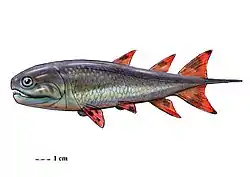Chagrinia
Chagrinia is a genus of prehistoric lobe-finned fish which lived during the Late Devonian period.
| Chagrinia Temporal range: Devonian | |
|---|---|
| Scientific classification | |
| Kingdom: | |
| Phylum: | |
| Class: | |
| Order: | |
| Family: | |
| Genus: | Chagrinia |
| Species: | C. enodis |
| Binomial name | |
| Chagrinia enodis Schaeffer, 1969 | |
The holotype, Chagrinia enodis, was found eroded out of the Chagrin Shale in the Euclid Creek Reservation in Cleveland, Ohio, in 1960 by a local citizen.[1][2]
The fossil material is poorly preserved, but the species appears to exhibit a slender boy, narrow caudal peduncle, symmetrical tail, and fin rays that outnumber the endochondral supports. The scales appeared to be unornamented, but that may be a preservational artefact.[3]
References
- Schaeffer, Bob (1962). A coelacanth fish from the Upper Devonian of Ohio. Scientific Publications of the Cleveland Museum of Natural History, New Series (Report). Cleveland: Cleveland Museum of Natural History. pp. 1–13.
- Carr, Robert K.; Jackson, Gary L. (2010). "The Vertebrate Fauna of the Cleveland Member (Famennian) of the Ohio Shale". In Hannibal, J.T. (ed.). Guide to the Geology and Paleontology of the Cleveland Member of the Ohio Shale. Ohio Geological Survey Guidebook 22. Cleveland: Ohio Geological Survey. p. 10.
- Forey 1997, pp. 346-347.
Bibliography
- Forey, Peter L. (1997). History of the Coelacanth Fishes. London: Kluwer. ISBN 9780412784804.CS1 maint: ref=harv (link)
This article is issued from Wikipedia. The text is licensed under Creative Commons - Attribution - Sharealike. Additional terms may apply for the media files.

.jpg.webp)


